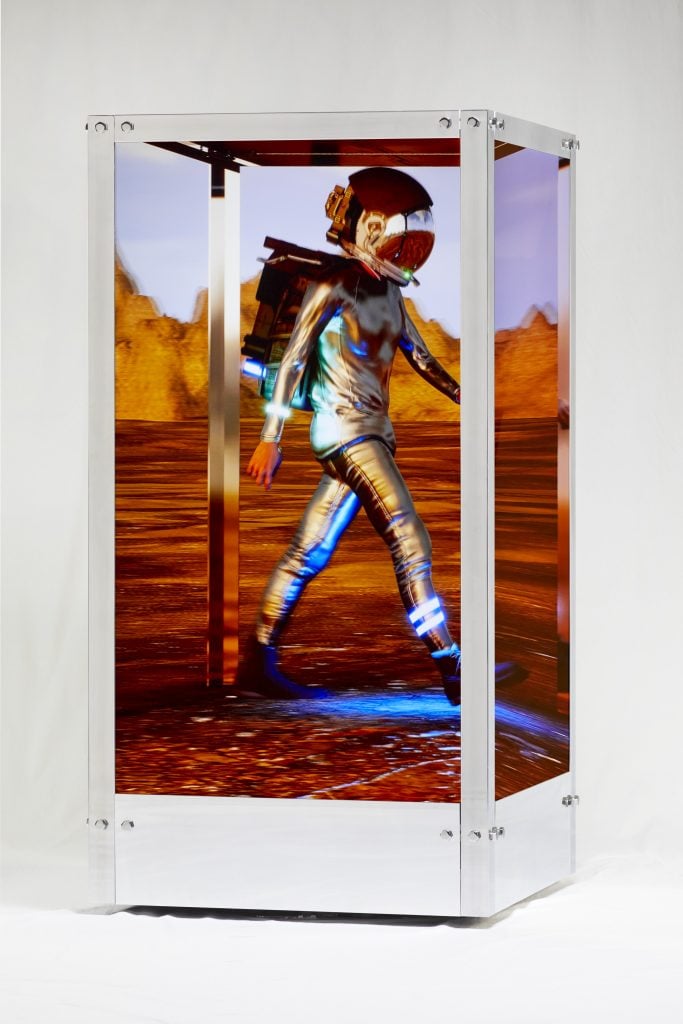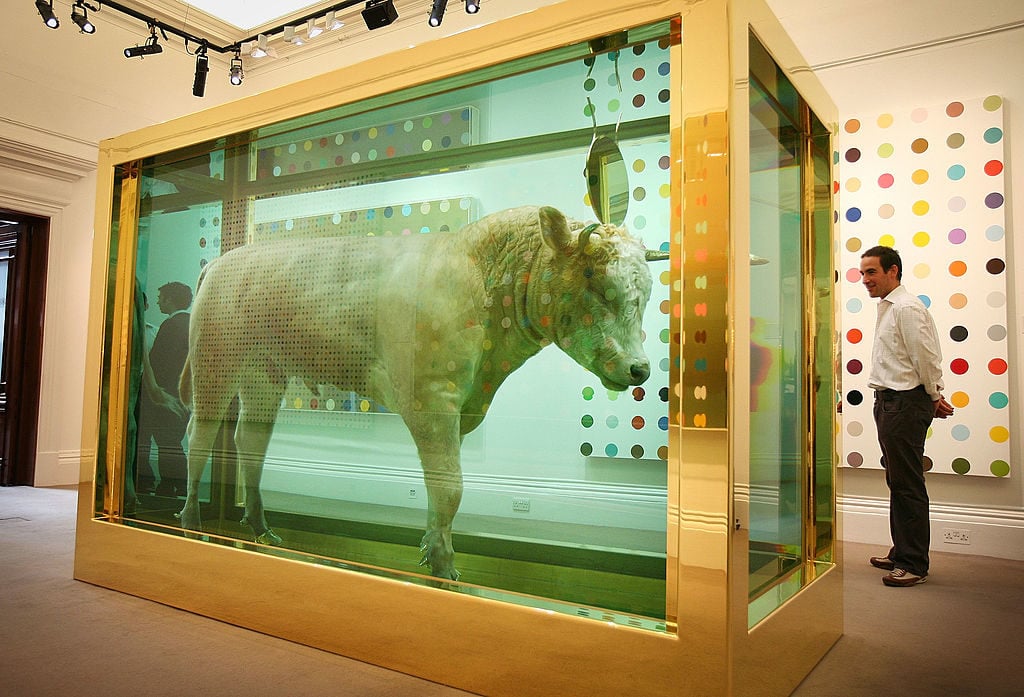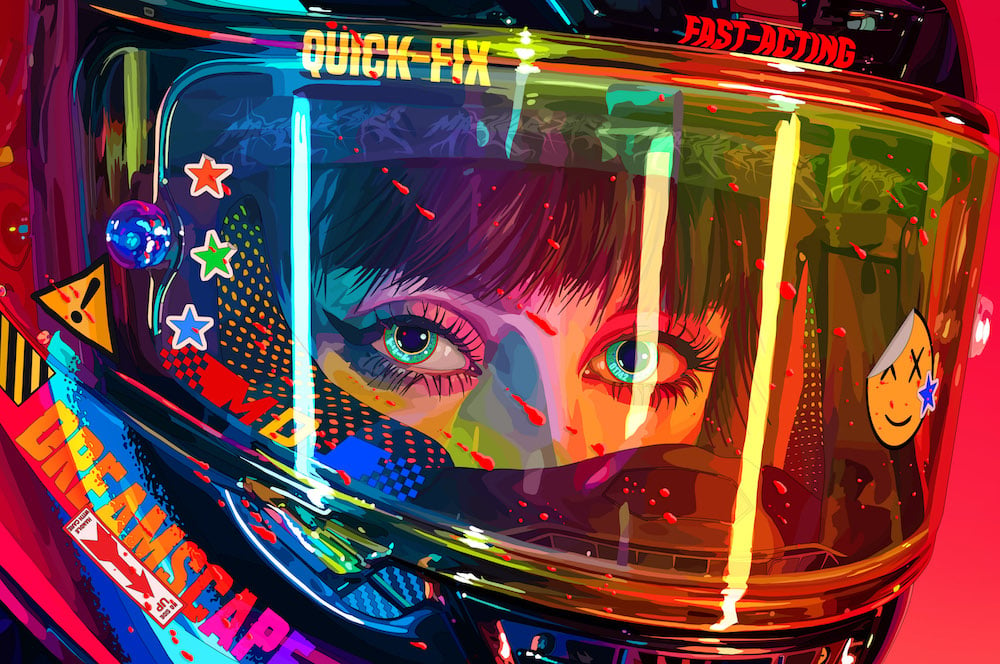Every Wednesday morning, Artnet News brings you The Gray Market. The column decodes important stories from the previous week—and offers unparalleled insight into the inner workings of the art industry in the process.
This week, breaking down and building up anew…
TOKEN INVOLVEMENT
Understandably, conversations about NFTs in the art world have been dominated by the mind-melting prices paid at Christie’s, Sotheby’s, and Phillips for works by crypto-conversant artists, many of whom were largely unknown to the fine-art establishment before March 2021. But somewhat lost amid the frenzy has been the one way in which the NFT power surge matters to every art professional: as the next step in the decades-long march toward merging the primary and secondary art markets into an undifferentiated sales space.
More specifically, the major auction houses’ swift, strong, and steady embrace of NFT sales this year also doubles as their most concerted move into selling directly to buyers on behalf of the artists themselves. The best hope of projecting where the road leads from here can only come from viewing this juncture in the context of what has led up to it, as well as what makes crypto fundamentally different terrain than earlier milestones on the journey.
First, it’s worth speeding through a highlight reel of the Big Three’s big year in NFTs. Christie’s set off the entire auction-house/NFT glitter bomb when it sold Beeple’s (aka Mike Winkelmann) token-backed digital collage Everydays: the First 5,000 Days (2021) for an explosive $69.3 million in March. (All final prices include fees; presale estimates do not.) At its marquee 21st-century evening sale in New York last week, the house went back to the source of the boom by offering HUMAN ONE (2021), a lot consisting of Beeple’s first-ever physical work and its corresponding NFT. Doubly unusual, Christie’s both consigned the piece from the artist and guaranteed him a minimum price for the privilege. The move paid off; the lot nearly doubled its $15 million presale estimate by landing at $29 million. (Christie’s declined to comment for this story.)
Sotheby’s waded into the crypto space in April (in partnership with Nifty Gateway) by selling $17 million worth of NFT-certified works straight from the digital studio of pseudonymous sensation Pak. The House of Drahi followed up this success with its “Natively Digital” NFT sale in June, in which it consigned nearly every lot from the artists themselves en route to a $17 million auction total. From October 18 to 26, Sotheby’s brought another $18.6 million worth of NFT sales during a sequel to “Natively Digital” that christened its Metaverse crypto platform. This time, the lots were predominantly consigned from the vaults of 19 collectors.
Phillips was quick to plant its own seeds in the blossoming market. First, it consigned a programmatic NFT (meaning, one coded to behave in a dynamic way, not just track ownership on a blockchain) from Mad Dog Jones; the work hit $4.1 million, making Jones the priciest living Canadian artist at auction in the process. The house has gone on to offer direct-from-the-artist(s) NFTs in multiple sales, headlined by five bundles of “Bitchcoin” NFTs from blockchain early-adopter (and Artnet News op-ed contributor) Sarah Meyohas, which amassed nearly $400,000 in sales this May.
Considered against the thousands of blockchain-based transactions happening every day across cryptocurrency markets, non-art NFTs, decentralized finance, and more, the Big Three auction houses’ forays into NFTs might seem minor. But considered against the history of the traditional art market, I think they qualify as a daredevil mission into terra incognita—albeit one with precedents.

Beeple, HUMAN ONE(2021), sold for $29 million (est. $15 million) at Christie’s November 2021 “21st century art” evening sale in New York. Courtesy Christie’s.
A BRIEF HISTORY OF BLURRING BOUNDARIES
The primary and secondary art markets have been collapsing into one another by fits and starts for roughly three decades. When Phillips chair Cheyenne Westphal started her auction career at Sotheby’s in 1990, she told me for an earlier story, “There was a rule that you wouldn’t offer an artwork by a living artist that wasn’t at least 10 years old, so nothing truly contemporary was offered in a postwar sale.” It all seems so old-fashioned now, doesn’t it?
Among the most visible landmarks in auction houses’ embrace of the new were Sotheby’s sales of objects and ephemera from Damien Hirst’s Pharmacy restaurant in 2004 and his “Beautiful Inside My Head Forever” auction in 2008—sales that “bypassed any gallery system and did something you would call ‘direct to consumer,’ which was definitely not a term used in the art world at the time,” Westphal said.
These unorthodox primary-market auctions followed muddier milestones. In 1996, Sotheby’s acquired André Emmerich Gallery, then primarily known for an artist roster rich in American color-field painters such as Morris Louis and Kenneth Noland. Christie’s took a similar turn in 2007 by acquiring Haunch of Venison, the international contemporary gallery that then handled the likes of Richard Long, Bill Viola, and Rachel Whiteread.

Haunch of Venison, as seen from the street. Courtesy of Haunch of Venison.
Although both houses eventually sunset their respective experiments in representing living talent, the efforts segued into their establishment of robust private-sales departments that now generate more than $1 billion each in annual transactions. Sometimes those private-sales departments also program dedicated exhibition spaces. Sometimes they even feature work consigned to the houses directly from artists (though the practice is more common in Asia than in the West). For example, one of the pivotal episodes in Mr. Doodle’s trajectory to international art stardom was a selling exhibition at Sotheby’s Hong Kong in December 2019 where every work found a buyer.
A revolving door has also been installed between the executive offices at major auction houses and the blue-chip gallery sector over the past 30 years. The mid-1990s saw Lucy Mitchell-Innes and David Nash depart Sotheby’s to start their namesake gallery. Brett Gorvy followed suit two decades later by leaving Christie’s in 2016 to launch Lévy Gorvy; he and business partner Dominique Lévy later coaxed Christie’s vet Danqing Li to join them.
It should come as no surprise that the auction and dealer sectors have come to look more and more like one another over this span. Galleries increasingly showed and sold secondary-market works alongside pieces fresh from artist’s studios, including multiple instances where apex-level galleries exhibited and sold estates from major collectors, a business previously viewed as the exclusive province of auction houses. Meanwhile, auction houses became increasingly comfortable placing works by living artists under the hammer—first as day-sale experiments, then as evening-sale fixtures.
The picture blurred further as art advisors began sliding between roles too. We’ve come a long way from Sotheby’s upending the art-media news cycle by acquiring the high-powered Art Agency, Partners to absorb its principal talent (Amy Cappellazzo, Adam Chinn, and Allan Schwartzman) back in 2015. Between August and October of this year, we learned that not one but two new 360-degree art services firms would be formed by key personnel who had served prominent roles in multiple sectors.
First, Lévy and Gorvy announced they would join Salon 94’s Jeanne Greenberg Rohatyn and auction-specialist-turned-gallerist-turned-advisor Amalia Dayan to create the forthcoming LGDR; then Cappellazzo and Chinn announced they would connect with former Sotheby’s Asia dealmaker Yuki Terase to inaugurate Art Intelligence Global.
Take this intensifying cascade of crossover efforts together, and I don’t see it as a spontaneous left turn that the Big Three houses are eager to offer NFTs directly to buyers on the artists’ behalf. However, Sebastian Fahey, executive lead of Sotheby’s Metaverse, framed the house’s role as a primary-market crypto-seller more as an organic outgrowth of the medium than a product of market history.
“The point is this space—meaning NFTs and digital media—is not conforming to established practices of the traditional art forms. That permits us the opportunity to work with primary and secondary [transactions],” he said. He noted that it was “by design” that the original Natively Digital sale consisted predominantly of works consigned from artists, whereas the second focused on works consigned from collectors. Future Metaverse auctions will incorporate both arrangements in varying capacities.
Yet before we conclude that Sotheby’s, Christie’s, and Phillips will be able to seamlessly play this role for the long term, let alone become dominant players in the crypto space, it’s important to recognize that the NFT market presents a more complex proposition for big auction houses than the dealer sector ever did.

Damien Hirst’s The Golden Calf on display before the “Beautiful Inside My Head Forever” Sale at Sotheby’s in 2008. Photo courtesy of Peter Macdiarmid/Getty Images.
THE VIEW FROM THE OTHER SIDE
By the time major auction houses and dealers were regularly strafing into each other’s traditional domains, the top end of the gallery sector had already grown out of its community-based phase and flexed its muscles as a global business. I don’t necessarily want to say that the ends justified the increasingly nontraditional practices, but I do think they went a long way toward explaining them.
Despite the pupil-dilating prices regularly parading out of crypto-native platforms, however, most participants in the NFT market today still share a strong sense of ownership over the space’s trajectory—and with it, more than a little skepticism of legacy brands entering the ecosystem during what is by any measure an extraordinary bull run.
That was one of the themes of my conversation with Jonathan Perkins and John Crain, two of the cofounders (with Charles Crain) of NFT platform SuperRare. SuperRare emerged in 2018 out of a Telegram group chat of just 50 people and has gone on to become one of the most active NFT ecosystems operating. It was founded on the principle of trying to make buying and selling NFTs a more harmonious ecosystem for all parties involved, starting with embedding a 10 percent artist resale royalty into every transaction.
“As startup founders, we had a bleak couple of years from 2018 to 2020. Not many collectors, kind of rolling the boulder up the hill. But that gave us time to build a vibrant grassroots community with a real sense of ownership,” Perkins said. “We saw it as an inevitability: if NFTs took off, big auction houses would smell the money and try to get in—but it’s pretty transparent that they’re kind of late to the game.”
Beyond its origin story and prioritizing resale royalties, SuperRare’s crypto-native mindset is apparent in the way the founders have worked to evolve its operating principles. Crains and Perkins are now in the process of transferring governance of the platform to the community by forming a DAO (decentralized autonomous organization, where decision-making is collectivized and executed through smart contracts). The first act of the DAO is Space Race, in which the community gets to vote in five new curated “spaces” out of a group of 35 proposed by members around specific themes, such as digital work by Latinx creators, NFTs contextualized within art history, or text-based crypto-art.
Crain described the initiative as a reflection of SuperRare’s commitment to the “huge value” of not just human curation but bottom-up human curation; the idea is to give the platform ample room to grow while staying driven by the community. Members will be the ones to decide how much the Space Race reshapes the platform’s fundamentals, and in what way. “We’re trying to get the best of both worlds,” he said.
Not surprisingly, SuperRare’s approach to this aspect contrasts with the Big Three auction houses, whose main function to buyers of traditional art and collectibles has been to assess what is worth acquiring and at what prices literally for centuries.

Steve Aoki x Gal Yosef, MetaZoo-Mothman (2021), sold for more than $214,000 in the inaugural auction on Sotheby’s Metaverse in October 2021. Courtesy Sotheby’s.
“Sotheby’s throughout its history of 270-plus years has been bringing what the market is looking for that day,” Fahey said of the house’s pivot into the NFT marketplace. “Where we play an important role in this space is by providing a curatorial standpoint over the market.”
“Our specialists, in the same way that they do with traditional art forms, are able to assess the market and bring the artworks that we feel either play the most important part in the development of the NFT space and/or that will have longevity. And I think the market has been responding well to that.”
What Fahey means by “the market” is somewhat different than what SuperRare’s founders mean by “the community.” According to Sotheby’s, 25 percent of the buyers in its first “Natively Digital” sale were existing clients, versus 75 percent who were new to the house. (The “existing client” designation excludes the Pak sale because it was conducted in partnership with Nifty Gateway.) Fahey framed the split between new and old buyers as evidence of how early the art and crypto spaces still are in the crossover process.
This implies NFTs will mature as more longstanding buyers of fine art and collectibles enter the market, which is a perfectly reasonable mentality for a major auction house to have. It’s just that many crypto-natives and later adopters feel they don’t need the help.
The question will be how much the Big Three have to adapt in order to wield long-term influence in the crypto space. Fahey repeatedly championed Sotheby’s commitment to the blockchain but declined to offer details about how the house and its Metaverse platform might evolve in response to the particularities of NFTs and the larger crypto ecosystem, whose international legal and regulatory guidelines are still being hashed out on the fly.

XCOPY, A Coin for the Ferryman (2018), resold for 1,330 ETH (more than $6 million) on SuperRare in November 2021. Courtesy SuperRare.
However, he noted that Sotheby’s engagement with crypto has already progressed beyond NFTs, most notably in its decision to accept payment in select cryptocurrencies for a Banksy painting this May and two more that will mount the block at “The Now” sale in New York this Thursday night.
At the same time, this example highlights that crypto-native platforms are substantially ahead of the legacy auction houses from a technological standpoint. Perkins noted that SuperRare, like all platforms built on Ethereum, enables “a radically fast market.” Because money is escrowed on-chain, payouts to artists and resellers happen instantly. He exemplified the appeal of this system with a $6 million transaction on SuperRare during NFT.NYC, in which the artist, XCOPY, received their $600,000 resale royalty moments after the new buyer’s offer was accepted, simultaneous to when the platform’s cofounders received their commission: no 90-day payment terms for the buyer, no need for any of the parties to get on the phone with a lawyer to work through the terms.
That doesn’t mean the houses can’t catch up. Crain and Perkins both said they were impressed at how much Christie’s and Sotheby’s had adapted already. But when I asked Crain about the future, he drew an analogy that has stuck with me.
“Think about broadcast media. If you were NBC, you thought, ‘I’m the king of the world. Everyone watches the news here.’ And then YouTube comes along and everyone can create content. It leveled the playing field,” he said. “It didn’t get rid of legacy media, but it gave people a lot more optionality.”
So I don’t think the Big Three houses will be blown out of the NFT game in the future. But it’s entirely possible that they could mainly cater to a mainstream subset of collectors rather than dominating the market. And while that result could still be lucrative and influential for Sotheby’s, Christie’s, and Phillips, the destination would also be significantly different than in every art-world border-crossing they’ve made before.
That’s all for this week. ‘Til next time, remember: we’re all on a long, winding road.












